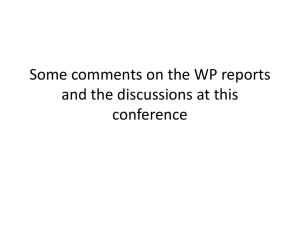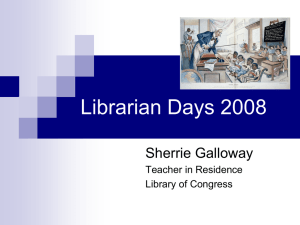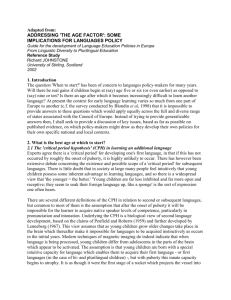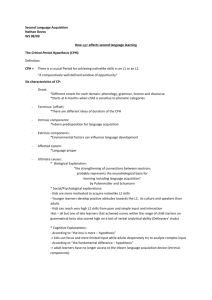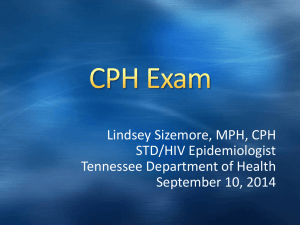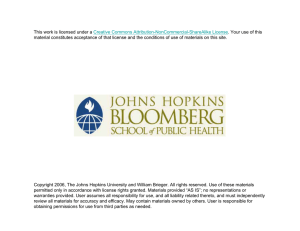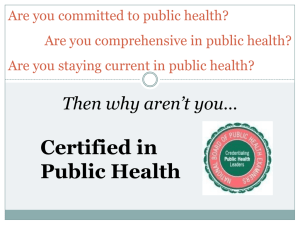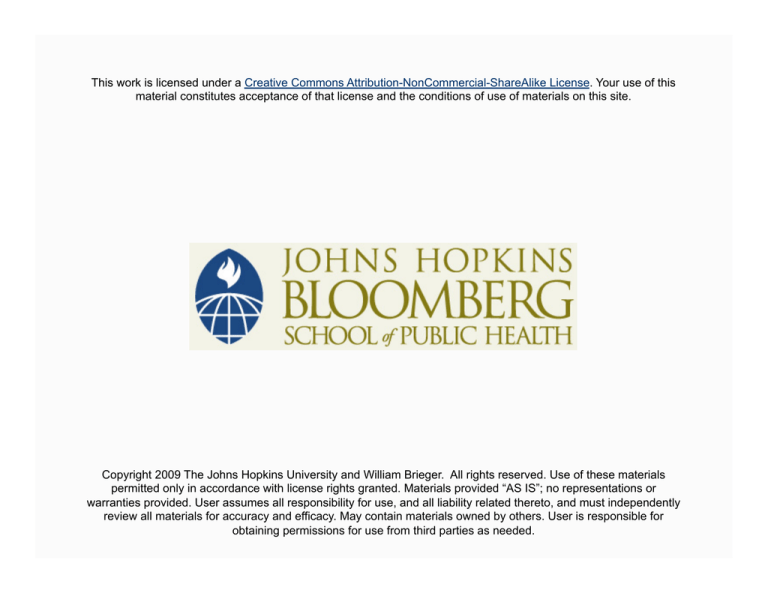
This work is licensed under a Creative Commons Attribution-NonCommercial-ShareAlike License. Your use of this
material constitutes acceptance of that license and the conditions of use of materials on this site.
Copyright 2009 The Johns Hopkins University and William Brieger. All rights reserved. Use of these materials
permitted only in accordance with license rights granted. Materials provided “AS IS”; no representations or
warranties provided. User assumes all responsibility for use, and all liability related thereto, and must independently
review all materials for accuracy and efficacy. May contain materials owned by others. User is responsible for
obtaining permissions for use from third parties as needed.
Community Health Coalitions in
Urban Nigeria, 1994–2005
William Brieger, MPH, CHES, DrPH
Johns Hopkins University
Section A
The Nigerian Urban Environment
Urbanization in Nigeria
The Southwest
- Settlements surpassing 20,000 over 150 years ago
- Yoruba kingdoms with central towns and satellite farm hamlets
The North
- Historical empires with several large cities
- Hausa, Fulani, Borno
The East
- Igbo: rural, autonomous communities
- Urban areas developed through colonialism
4
Lagos—The Megalopolis
Photos by William Brieger
5
Kano’s Wall and Gates Still Stand
Photos by William Brieger
6
Aba—A Growing Business Center
Photos by William Brieger
7
Nigeria’s Urban Political Structure
Formerly, metropolitan councils
- Underpinnings of indigenous leadership, chiefs
Now, local government areas
- Ibadan, e.g., now comprises five LGAs
- LGAs are responsible for primary-level services
Health, education, sanitation, infrastructure
LGA funding sources
- Mainly from federal subventions
- Supplemented by rates, fees, licenses, rents, and head taxes
8
Nigeria’s Health Care
Federal specialist hospitals
- Often in universities
State government specialists
and general hospitals
LG health centers
Private for-profit clinics and
hospitals
Mission hospitals
Patent medicine vendors
Indigenous healers
Photo by William Brieger
9
Lagos—Health Care Access
Rural/urban dichotomy may be false
Poverty is the major factor
- Many communities are underserved
- Preference for government and PMVs
- But private seen as reliable
PMVs termed hospitals for the urban poor
Note: PMV = patent medicine vendor
10
Nigeria’s Social Welfare
No real insurance schemes or social welfare systems at national,
state, or LGA levels
Social networks are a key mechanism for urban survival
Voluntary associations
- Religious based
- Ethnic/hometown
- Residential
-
-
Social clubs
Trade/union
11
Section B
The Concept of a Coalition
Coalition Definitions, Characteristics
An organization of individuals …
- Representing diverse organizations, factions, or constituencies
- … who agree to work together
- … in order to achieve a common goal
An organization of diverse interest groups that …
- Combine their human and material resources
- … to effect a specific change
- … which members are unable to bring about independently
In short, coalitions are usually organizations of organizations that
bring different strengths together
13
Coalitions Come Together to Address Many Issues
Youth development
Drug abuse
Preserving neighborhood schools
HIV/AIDS
Protecting a community library
Environmental pollution by nearby
factories
Traffic safety
Neighborhood security
Photo by William Brieger
Photo by William Brieger
14
Coalition Functions
Management and coordination of available community resources,
including leadership and human resources, to achieve goals
Advocacy within and beyond the community to generate new
policies, resources, and support to meet local needs
Education and mobilization of coalition members and community
residents to use resources that will improve their health and welfare
Exchange and sharing of successful strategies among coalition
members to enhance member functioning
15
Why Are Coalitions Important?
Butterfoss, Goodman, and Wandersman reviewed the important role
of coalitions
The coalition strategy is needed to augment traditional individualoriented behavior change strategies because …
- “The current wisdom in health promotion holds that targeting
the behavior of individuals, without also intervening at these
other social levels that shape behavior, will not have as great
an impact on health status”
Thus, coalition building is a strategy aimed at “strengthening the
social fabric”
16
United in Coalition
Coalitions …
- Enable organizations to become involved in new and broader
issues without having the sole responsibility for managing or
developing those issues
- Demonstrate and develop widespread public support for issues,
actions, or unmet needs
- Maximize the power of individuals and groups through joint
action
Increase critical mass behind community effort by helping
individuals achieve objectives beyond the scope of any one
individual or organization
17
Stages of Coalition Formation
Butterfoss et al.
- Formation
- Implementation
- Maintenance
- Accomplishment of goals
McElroy et al.
- Coalitions must develop an organizational form
- Recruit
-
-
-
Retain new members
Socialize new members
Carry out a plan of action
18
Challenges of Evaluating Community Programs
Health outcomes/impact?
- Immunization coverage
- Mortality/morbidity, e.g., malaria
Social outcomes?
- Organizational structures and changes
- Community norm/law changes
- Community awareness changes
Kegler, Twiss, and Look. (2000). Health Educ Behav.
19
Indicators of Sustainability
Bossart, 1990
- Demonstrate effectiveness in reaching clearly defined goals
- Integrate activities into fully established administrative
structures
- Gain significant levels of funding from national sources
- Negotiate project design with a mutually respectful process
- Include a strong training component
20
Successful Coalitions
Exchange of resources and strategies among member organizations
- Inter-organizational cooperation, payoffs, benefits of joining
Require a minimum size to make the coalition effective
Clearly recognize and articulate a mutual need or concern
Have a history of previous collaboration and joint efforts among
members
Exhibit compatibility among potential partners
Are determined to work together
21
Some Thoughts
Sustain actual coalition as long as needed to solve the focal problem
Recognize that there are existing organizations
- Do not want to supplant them or subsume them in the process
Look outside the box for coalition building, leadership, and
resources
- Help people visualize how to leverage resources
- Diversity is both a resource and a challenge
22
Section C
Coalition of Community
Organizations and Private Providers
BASICS Nigeria
Basic Support for Institutionalizing Child Survival
- USAID, Nigeria
- Phase I: 1994–2001
Predecessor “REACH” project
- Documented that urban child immunization rates were lower
than national averages and falling
Began at the time of “decertification”
- Not allowed to work with government entities
- Needed innovative way to work with urban poor
24
Community Partners for Health (CPH)
Photo by William Brieger
Photo by William Brieger
Urban coalitions to promote child survival
A coalition is an organization of diverse interest groups that …
- Combine their human and material resources
- … to effect a specific change
- … which members are unable to bring about independently
25
CPHs Have Formed in Three Cities
Lagos 1995
Kano 1997
Aba 1999
Public Domain
26
Steps in CPH Development
Urban populations are also underserved
- Urban private sector inventory of community-based
organizations (CBOs) and health facilities (HFs)
- Community fora for CBOs and HFs to discuss CPH
- CPH formation
- Governing board formation
27
Steps in CPH Development
Urban populations are also underserved
- Urban private sector inventory of community-based
organizations (CBOs) and health facilities (HFs)
- Community fora for CBOs and HFs to discuss CPH
- CPH formation
- Governing board formation
- Memorandum of understanding (MOU)
Roles and responsibilities of partners
- Planning workshops—sub-project proposals
-
-
Constitution drafting and approval
Registration with corporate affairs commission
28
Timeline in CPH Development
Lagos
Kano
Aba
UPSI
1995
1996
1999
Community fora
1995
1997
1999
CPH
1996
1997
1999
Governing board
1996
1997
2000
MOU
1996
1998
2000
SPP
1996
1997
X
Constitution
1997
1998
2000
NGO registration
1998
1999
2001
29
CPH Structure with Dyads
Market Women
Association
Tailors' Union
Apostolic
Church
Muslim
Youth
Group
Hairdressers'
Association
Health Facility A
Health Facility B
Alfanda
Residents'
Association
Itire
Neighborhood
Association
Amuludun
Social Club
Unity
Women's
Club
Transport
Workers Union
Held together with constitution
30
Coalition Foundation—CBOs
Photo by William Brieger
Photo by William Brieger
31
CBOs—Indigenous Organizations
Photo by William Brieger
Photo by William Brieger
32
Private Health Care
Photos by William Brieger
33
The Communities
Ajegunle
Amukoko
Mushin
Lagos Island
Surulere
Makoko
Working class
Mixed ethnicity
Working class
Mixed ethnicity
Lower middle class
More from old Western Region
Lower class
Mostly original indigenous population
Middle class
More from old Western Region
Lower class
Indigenous minority, mixed ethnic
34
Perceptions of Cohesion, Integration, Control
Makoko
- “People are more prone to
cooperate on ceremony and
not on community progress”
Amukoko
- “There is ethnic distrust;
people only agree in their
own compounds”
Ajegunle
- “People in this community
know each other well, but I
do not think that they
cooperate”
Photos by William Brieger
35
Lagos—Community Efficacy Perceptions at the Start
36
Section D
Follow-up: Growth and Challenges
Lagos CPH Member Growth
Note: CBO = community-based organizations; HF = health facilities
38
Kano Membership Changes
Note: CBO = community-based organization; TBA = traditional birth attendant;
PMV = patent medicine vendor; HF = health facility
39
Overall 2000 Membership
40
Achievements: 1997–2001
Photo by BASICS Nigeria, USAID
Immunization
Women’s involvement
AIDS awareness
Democracy and governance
Environmental health
Conflict resolution
Exclusive breastfeeding (EBF)
promotion
Co-ops and credit
41
Local Adaptations in Programming
In Kano …
- Female literacy
- TBA training
- Local pomade
manufacture
Resulting in …
- Confidence to seek
health care
- Financial independence
Photo by William Brieger
42
There Is Power in Collective Action
Kano
- “Due to the CPH, the CBOs which were isolated before have
come together”
Aba
-
“Major achievements of the CPH include bringing together
diverse people of different religions, ethnic groups, etc.
Together they have united so that we feel a sense of
belonging.”
Enhances advocacy, approaching donors and local government
authorities (LGAs)
43
Ajegunle—Problems in Social Cohesion
“We were part of AJCPH before, but decided not to have anything
to do with it after our delegation walked out”
“The CPH idea is quite good, but the CPH is poorly run”
“There were ethnic tendencies, dishonesty, and a lack of
transparency”
“The MOU hasn’t been followed”
“Up till today, we haven’t got a solid bank account, which we ought
to have”
“People in this community know each other well, but I do not think
that they cooperate”
“One should not trust people in this community”
44
Makoko—Changes in Social Cohesion
1997
- “There is no unity in Makoko. People relate among people from
the same tribe.”
- “People are more prone to cooperate on ceremony and not on
community progress”
2001
- “Our CPH is united today. Often time problems or disputes
among us are settled within hours.”
-
“The constitution has stabilized the organization so that there is
no conflict”
45
Women Empowerment
1997
- 11% CBOs joined because of
“opportunities for women’s
empowerment”
1998–2000
- Workshops on democracy,
governance, women’s rights
Photo by William Brieger
2001
- Credit and loan facilities
- Active participation in elections
- Community mobilization for NID,
EBF
46
Testimony from Makoko
“It made me have confidence in myself. I can face a crowd now. I
can now ask for my rights. Anytime a child has temperature, I now
know how to cool down such child’s temperature. I attended
seminars on democracy and governance, on women’s rights, and I
attended seminar on how to manage money, how to run business to
yield interest and how to return micro-credit loan.”
47
Liaisons—Essential for Survival
Local government
- LG officials attending CPH seminars
- CPHs mobilize for immunization
- CPHs assist in conflict resolution
Donors
- UNICEF supplies and seminars
- Office of transition initiatives (USAID)
NGOs
- CEDPA programs on reproductive health
- Local groups like COWAN for guidance
48
National Immunization Days: CPH-LGA Collaboration
Photo by BASICS Nigeria, USAID
CPH Strengths recognized by LGA
- Mobilization
- Local knowledge
- Grassroots reach
- Culturally acceptable (Kano)
Benefits to CPH
- Their own child protected
- Community awareness of
CPH
49
Cultural Interpretations of Vaccination
Rumors spread that vaccination
is a form of population control
Health workers in Kano have a
hard time convincing people to
participate so throw out
vaccines
CPH members able to
communicate with own
community members
Photo by BASICS Nigeria, USAID
50
Additional Areas of LGA-CPH Collaboration
Environmental sanitation
- Lawanson gets funds from LGA
- Aba CPHs get tipper trucks to help
HIV/AIDS awareness
Family planning commodity distribution
- Ajegunle + Amukoko with Ajeromi-Ifelodun LGA
Note role of CEDPA
51
Financial Sustainability
Main and potential sources of income
Membership dues (individual and CBO)
Campaigns
Income generation, commercial ventures
Interest from co-ops and credit schemes
Proposals and grants
In 1997, only two rated able to generate income
- Lawanson: materials from UNICEF, community fundraising
campaign, drug store
- JAS/Mushin: savings and loan cooperative, ambulance, rental
shops
52
2001 Financial Outlook
Profit from micro-credit loans in Lawanson
- One-third for CPH administration
- One-third for child survival programs
- One-third for more loans
But potential dissention among those who don’t pay back
or don’t receive in turn
Lament from Makoko
- “A parent (BASICS) has to continue to assist his child. There is
no place we can go for financial support. Our government can't
give financial support to any NGO like American government
does. We don't have money, nothing. So we can't stand on our
own. There is no way to generate funds.”
53
Issue of Dues
Lagos
- CBOs accept the need for annual dues
- But say dues cannot support CPH administration
Kano
- Belief that initial registration fee once and for all is better
- Leaders fear people will be scared away by dues
- Use levies from time to time instead of dues
Aba
-
-
Only one CPH started collecting dues successfully
Other leaders fear dues will dissuade members
Overall, recognize that dues cannot sustain
54
Essential Inputs for Sustainability
BASICS
- Training on planning, governance, proposal writing
- Requirements to develop actual plans, proposals
- Facilitating constitution writing
- Initial conflict resolution guidance
Some “broken promises,” too
Community
- Attracting more dues-paying and committed CBOs
-
-
-
Liaison with local government, donors, NGOs
Subsequent independent conflict resolution—using the
constitution to solve problems
Income generation, fundraising, grants
55
The Value of Workshops
“Proposal writing helps prepare us for independence” (Lagos)
“It is the workshop that make we women know our rights and to be
able to ask for it from the government” (Lagos)
“Everybody feared having relationships with any American
organization. That workshop given by Bebeji wiped out all our fears
and we began the journey towards setting up a strong CPH.” (Kano)
“The trainings helped us to understand our community better” (Aba)
“The training has prepared us. We will try to see how we can help
ourselves.” (Kano)
56
Section E
Questions of Sustainability: More Than Just Intentions
Views on Sustainability
Aba: “The CPHs will last 10 years …”
“Because as time goes on, money will be raised through proposals to
donor agencies and money from dyad levies will increase. The main
strength of our CPH is in the leadership since they are a strong
team.” (youth leader)
“Since all of us want our children to survive, so we should do all we
could to see that we maintain the organization even more than 10
years” (male CBO leader)
“Because our members abide by the constitution and there has been
peace in the CPH” (female CBO leader)
58
Kano Predicts CPHs Will Last …
Photo by William Brieger
“By the Grace of God it will go on beyond 10 years. The CPH has been
accepted by the people. Education, sanitation, and health issues are the
strengths.”
“Because the way it is run now makes it possible for community members to
enjoy good programs”
“If the focus remains without influencing the tradition and religious belief
of the people. And if the process is transparent.”
59
Where Will We Be in 10 Years in Lagos?
Makoko
- “Since we are alive nothing
bad will happen to the CPH.
That is why we are
recruiting new youth
members. Once we have
money to maintain the CPH,
we shall continue running
the CPH. This is evidence
for our relationship with the
local government.”
Mushin
- “Members are very much
interested in making it live.
The cooperative and microcredit and the health care
programs are the main
strengths. We organize good
programs and fundraising
activities.”
60
Ajegunle 2001 Thoughts
“I am very optimistic that the CPH will continue functioning in 10
years time. This is mainly because of the cooperative society which
has been firmly established.”
Photo by William Brieger
61
Ajegunle 2003
Photo by William Brieger
“Ajegunle is the poorest and highly
populated mostly with youth. Our children
were not empowered to go to school.
These youths are easily used as agent of
stabilization in this community. Most of
these youth don’t have anything doing and
thus politician use them mostly as agent of
conflict.”
“Now we are able to go to community and
call community meetings and thrash out
issues that can lead to conflict”
62
Lagos CPH Dyad Growth
Dyads average 6–7 community-based organizations/health facilities
63
Continued Lagos CPH Action in 2005
Inter-CPH forum
OTI grants for D&G
CEDPA grants for CBD (RH)
Japanese International
Cooperation Agency (JICA)
support for RBM
Photo by William Brieger
Photo by William Brieger
64
But in Kano …
None found in 2005
Internal squabbles
Absorption by larger CBOs
Photo by William Brieger
Loss of private health facility partners
Ethnic tensions with patent medicine vendors
Political favoritism in programs like immunization
65
CPH Challenges
Dependent on leadership from professional members
- In Makoko, Lagos, no resident health staff in the few available
health facilities
- Similar problem in Kano; most no longer function
- Involvement of TBAs, traditional healers, and PMVs could not
substitute
Self-help spirit varied by region/state
- Strong cooperative spirit and infrastructure in Lagos
Poverty a major concern in terms of internal fundraising
Different histories in terms of relationship with and expectations of
government
66
Revisiting Indicators of Sustainability
Goals
- Output measures, but need
outcome, impact
Negotiate—respectful process
- CBOs and HFs, BASICS and
CPHs
Administrative structures
- Corporate affairs
registration, inter-CPH
forum
Training component
- Technical and managerial
Recruitment and growth
- Numbers of dyads increase
over time
Funding sources
- CEDPA, OTI, JICA, proposals
67
Community Efficacy Revisited
Though a follow-up survey was not done, one can see a relationship
between efficacy perceptions and visions of a sustainable future
For example, greater claims of organizational capacity and
sustainability in Ajegunle show that efficacy perceptions might
improve when people see the results of their own actions
Surulere and Mushin remained strong
Makoko, with relatively higher initial community efficacy
perceptions, did not survive
- There are obviously other ingredients in the mix, such as
leadership
68
Central Functions Still Needed
Sustainability needs a larger structure than single CPHs
In Lagos the inter-CPH forum helps …
- Leadership, management training for new leaders
- Bridging and follow-through with proposal writing, vetting, and
acceptance
- Conflict resolution/mediator
Ideally, success would be the forming of new CPHs
- Although new dyads within CPHs formed
- A major challenge is new NGO registration process
69
Conclusions
Lagos CPHs progressed through the following stages:
- Formation
- Implementation
- Maintenance
- Accomplishment of goals
Where they work, coalitions help …
- Mediate individual needs
- Advocate for community improvements
-
-
Link health with development
Address infrastructural improvements and conflict resolution
70

